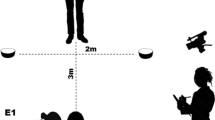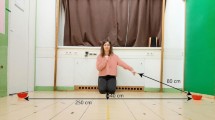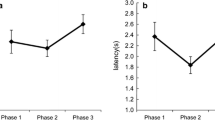Abstract
In spite of the rather different procedures actually used in comparative studies to test the ability of different species to rely on the human pointing gesture, there is no debate on the high performance of dogs in such tasks. Very little is known, however, on the course through which they acquire this ability or the probable factors influencing the process. Important developmental questions have remained unsolved and also some methodological concerns should be addressed before we can convincingly argue for one interpretation or another. In this study we tested 180 dogs of different age (from 2 months to adults) to investigate their performance in the human distal momentary pointing gesture. The results, analyzed at both the group and the individual levels, showed no difference in the performance according to age, indicating that in dogs the comprehension of the human pointing may require only very limited and rapid early learning to fully develop. Interestingly, neither the keeping conditions nor the time spent in active interaction with the owner, and not even some special (agility) training for using human visual cues, had significant effect on the success and explained individual differences. The performance of the dogs was rather stable over time: during the 20 trials within a session and even when subsamples of different age were repeatedly tested. Considering that in spite of the general success at the group level, more than half of the dogs were not successful at the individual level, we revealed alternative “decision-making rules” other than following the pointing gesture of the experimenter.



Similar content being viewed by others
Notes
Agility is a canine version of the horse show jumping competition, in which a dog and a human work together so that the dog successfully navigates a series of obstacles arranged in a random course. The goal is to complete the course with the least number of faults and at the fastest time. The handler’s job is to help the dog overcome all the obstacles in the sequence, prescribed by the judge. As the dog runs the course off-lead, the success of the team depends greatly on the ability of the dog to rely on the communicative signals of the handler.
References
Anderson JR, Sallaberry P, Barbier H (1995) Use of experimenter given cues during object- choice tasks by capuchin monkeys. Anim Behav 49:201–208
Call J, Agnetta B, Tomasello M (2000) Social cues that chimpanzees do and do not use to find hidden objects. Anim Cogn 3:23–34
Erdőhegyi Á, Topál J, Virányi Zs, Miklósi Á (2007) Dog-logic: inferential reasoning in a two-way choice task and its restricted use. Anim Behav 74:725
Hare B, Tomasello M (1999) Domestic dogs (Canis familiaris) use human and conspecific social cues to locate hidden food. J Comp Psychol 113:173–177
Hare B, Brown M, Williamson C, Tomasello M (2002) The domestication of cognition in dogs. Science 298:1634–1636
Hare B, Plyusnina I, Ignacio N, Schepina O, Stepika A, Wrangham R, Trut L (2005) Social cognitive evolution in captive foxes is a correlated by-product of experimental domestication. Curr Biol 15:226–230
Itakura S, Agnetta B, Hare B, Tomasello M (1999) Chimpanzee use of human and conspecific social cues to locate hidden food. Dev Sci 2:448–456
Kaminski J, Riedel J, Call J, Tomasello M (2005) Domestic goats (Capra hircus) follow gaze direction and use some social cues in an object choice task. Anim Behav 69:11–18
Lakatos G, Dóka A, Miklósi Á (2008) The role of visual cues in the comprehension of the human pointing signals in dogs. Int J Comp Psychol 4:20
Ma L, Lillard AS (2006) Where is the real cheese? Young children’s ability to discriminate between real and pretend acts. Child Dev 77(6):1762–1777
Maros K, Gácsi M, Ádám M (2008) Comprehension of human pointing gestures in horses (Equus caballus). Anim Cogn 11(3):457–466. doi:10.1007/s10071-008-0136-5
McKinley J, Sambrook TD (2000) Use of human-given cues by domestic dogs (Canis familiaris) and horses (Equus caballus). Anim Cogn 3:13–22
Miklósi Á, Soproni K (2006) A comparative analysis of animals’ understanding of the human pointing gesture. Anim Cogn 9:81–94
Miklósi Á, Polgárdi R, Topál J, Csányi V (1998) Use of experimenter given cues in dogs. Anim Cogn 1:113–121
Miklósi Á, Kubinyi E, Topál J, Gácsi M, Virányi Zs, Csányi V (2003) A simple reason for a big difference: wolves do not look back at humans, but dogs do. Curr Biol 13:763–766
Miklósi Á, Pongrácz P, Lakatos G, Topál J, Csányi V (2005) A comparative study of the use of visual communicative signals in interactions between dogs (Canis familiaris) and humans and cats (Felis catus) and humans. J Comp Psychol 119:179–186
Range F, Aust U, Steurer M, Huber L (2008) Visual categorization of natural stimuli by domestic dogs. Anim Cogn 11(2):339–347. doi:10.1007/s10071-007-0123-2
Riedel J, Schumann K, Kaminski J, Call J, Tomasello M (2007) The early ontogeny of human–dog communication. Anim Behav. doi:10.1016/j.anbehav.2007.08.010
Topál J, Miklósi Á, Csányi V (1997) Dog–human relationship affects problem solving behavior in the dog. Anthrozoös 10:214–224
Virányi Zs, Gácsi M, Kubinyi E, Topál J, Belényi B, Ujfalussy D, Miklósi Á (2008) Comprehension of human pointing gesture in young human-reared wolves (Canis lupus) and dogs (Canis familiaris). Anim Cogn 11(3):373–387. doi:10.1007/s10071-007-0127-y
West RE, Young RJ (2002) Do domestic dogs show any evidence of being able to count? Anim Cogn 5(3):183–186
Acknowledgments
We are grateful to Katalin Farkas, Anita Kurys and Zsófia Virányi for acting as experimenters and helping in data processing. This study was funded by the OTKA (T049615), the EU: FP6 NEST (012878) and the Bolyai Foundation of the Hungarian Academy of Sciences. The experiments comply with the current laws of Hungary.
Author information
Authors and Affiliations
Corresponding author
Electronic supplementary material
Below is the link to the electronic supplementary material.
Video S1 (WMV 5065 kb)
Rights and permissions
About this article
Cite this article
Gácsi, M., Kara, E., Belényi, B. et al. The effect of development and individual differences in pointing comprehension of dogs. Anim Cogn 12, 471–479 (2009). https://doi.org/10.1007/s10071-008-0208-6
Received:
Revised:
Accepted:
Published:
Issue Date:
DOI: https://doi.org/10.1007/s10071-008-0208-6




